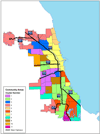Neighborhood-level associations with HIV infection among young men who have sex with men in Chicago
- PMID: 26168977
- PMCID: PMC4561028
- DOI: 10.1007/s10508-014-0459-z
Neighborhood-level associations with HIV infection among young men who have sex with men in Chicago
Abstract
The rising incidence of HIV infection among young men who have sex with men (YMSM) is a substantial public health concern. Traditional research on HIV among YMSM has focused largely on individual-level predictors and infrequently accounts for contextual or neighborhood-level factors such as ethnic composition and socioeconomic status. This study used neighborhood-level data from the US Census and other public sources, and individual-level data from a longitudinal cohort of YMSM in Chicago (Crew 450). Of the original 450 YMSM in the cohort, 376 reported living in Chicago (83.6 %) and were included in the analytic sample. A clustering approach was used to group the 77 community areas together by common characteristics, resulting in the identification of 11 distinct clusters. An unconditional model of individual HIV status indicated a significant amount of variance existed between neighborhood clusters (χ (2) = 21.66; p = 0.006). When individual-level variables were added to the model, only having an HIV-positive sex partner (OR = 6.41; CI 2.40, 17.1) and engaging in exchange sex in the past 6 months (OR = 3.25; 95 % CI 1.33, 7.93) were significant predictors of HIV status. Clusters with higher Walk Scores were less likely to contain HIV-positive individuals (OR = 0.94; 95 % CI 0.90, 0.98). Conversely, clusters with a larger proportion of vacant buildings were more likely to contain HIV-positive individuals (OR = 1.19; 95 % CI 1.07, 1.33). Future research among YMSM needs to investigate the mechanisms by which neighborhood of residence might influence engagement in risk behaviors or acquisition of HIV.
Figures
References
-
- Amirkhanian YA, Kelly JA, McAuliffe TL. Identifying, recruiting, and assessing social networks at high risk for HIV/AIDS: methodology, practice, and a case study in St Petersburg, Russia. AIDS Care: Psychological & Socio-Medical Aspects of AIDS/HIV. 2005;17(1):58–75. - PubMed
-
- Bell BA, Ferron JM, Kromrey JD. Cluster Size in Multilevel Models: The Impact of Sparse Data Structures on Point and Interval Estimates in Two-Level Models; Paper presented at the Proceedings of the Joint Statistical Meetings, Survey Research Methods Section; Alexandria, VA. 2008.
Publication types
MeSH terms
Grants and funding
LinkOut - more resources
Full Text Sources
Other Literature Sources
Medical
Miscellaneous



